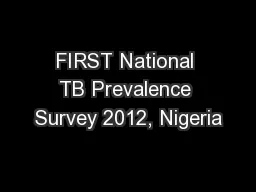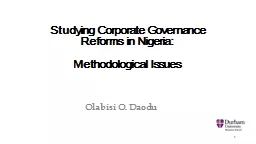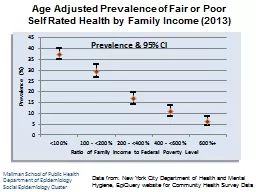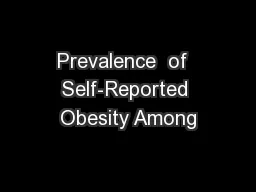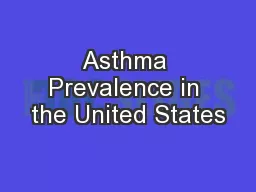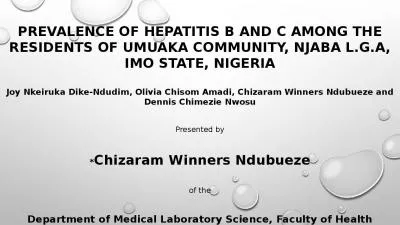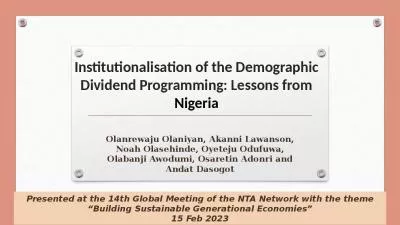PDF-FIRST National TB Prevalence Survey 2012, Nigeria
Author : yoshiko-marsland | Published Date : 2016-07-13
1 federal FIRST National TB Prevalence Survey 2012 Nigeria federal 4 Prior to 2012 there was no national survey to determine the prevalence of tuberculosis disease
Presentation Embed Code
Download Presentation
Download Presentation The PPT/PDF document "FIRST National TB Prevalence Survey 2012..." is the property of its rightful owner. Permission is granted to download and print the materials on this website for personal, non-commercial use only, and to display it on your personal computer provided you do not modify the materials and that you retain all copyright notices contained in the materials. By downloading content from our website, you accept the terms of this agreement.
FIRST National TB Prevalence Survey 2012, Nigeria: Transcript
1 federal FIRST National TB Prevalence Survey 2012 Nigeria federal 4 Prior to 2012 there was no national survey to determine the prevalence of tuberculosis disease TB in Nigeria Estimates of th. National Center for . Environmental Health. Division of Environmental Hazards and Health Effects. June 2014. CDC’s National Asthma Control Program (NACP) was created in 1999 to help the millions of people with asthma in the United States gain control over their disease. The NACP conducts national asthma surveillance and funds states to help . Nigeria is made of 36 states and Abuja the federal capital territory, 774 local government area, 300 indigenous languages and IGBO HAUSA AND YORUBA are the major tribes.. BRIEF HISTORY OF NIGERIA. The name Nigeria was adopted to designated the British protectorate on the river Niger. Being one of the major British colonies ,Nigeria was granted independence in 1960 under a constitution which provided a parliamentary government .. . Boko Haram and . Shari’a. Law. Shari’a. . law adopted in 12 northern states in Nigeria. History of . Shari’a. in Nigeria. Comes from Maliki Law – 8. , Authority and Power . AP Comparative Government. National Question. Despite being independent since 1960, Nigeria deals with a . “national question” . as to the direction the government should move. CASSAVA CAN INJECT TEN (10) TRILLION NAIRA ANNUAL INCOME INTO THE NIGERIAN ECONOMY.. A PRESENTATION TO . THE HONOURABLE MINISTER OF AGRICULTURE AND RURAL DEVELOPMENT. . CHIEF AUDU I . OGBEH, . OFR. . Reflections on methodological challenges and solutions. Olabisi O. Daodu . . 1. Outline. Overview of the study;. Research aim and questions. Methodology. Research approach and methods. Data collection. Data from: New York City Department of Health and Mental Hygiene, . EpiQuery. website for Community Health Survey Data. Mailman School of Public Health. Department of Epidemiology. Social Epidemiology Cluster. U.S. . . Adults by State . and Territory. Definitions. Obesity: Body Mass Index (BMI) of 30 or higher.. Body Mass Index (BMI): A measure of an adult’s weight in relation to his or her height, . calculated by using . Eight years after the introduction of the president's . privatisation. . programmes. , Nigerians are still waiting for a guaranteed electricity supply, running water, sewerage services, improved rail and road services and telephone facilities. . National Center for . Environmental Health. Division of Environmental Hazards and Health Effects. June 2014. CDC’s National Asthma Control Program (NACP) was created in 1999 to help the millions of people with asthma in the United States gain control over their disease. The NACP conducts national asthma surveillance and funds states to help . INDIA 2015 - 201 9 – A SUMMARY REPORT SURVEY CONDUCTED BY: Dr. Rajendra Prasad Centre for Ophthalmic Sciences, AIIMS, New Delhi National Programme for Control of Blindness &Visual Impairment, Dire Being the Maiden Edition of Archbishop Maxwell . Anikwenwa. Annual Public Lecture at Paul University, . Awka. . By . Nnaemeka. Achebe, CFR, . mni. Obi of Onitsha. Outline. Introduction & Rationale for Lecture Topic. Joy . Nkeiruka. Dike-. Ndudim. , Olivia . Chisom. . Amadi. , . Chizaram. Winners . Ndubueze. and Dennis . Chimezie. . Nwosu. Presented by. *. Chizaram. Winners . Ndubueze. of the. Department of Medical Laboratory Science, Faculty of Health Sciences, Imo State University, . Nigeria. . Olanrewaju Olaniyan, . Akanni. Lawanson, Noah Olasehinde, . Oyeteju. Odufuwa, . Olabanji. Awodumi, . Osaretin. . Adonri. and . Andat. . Dasogot. Presented at the 14th Global Meeting of the NTA Network with the theme “Building...
Download Document
Here is the link to download the presentation.
"FIRST National TB Prevalence Survey 2012, Nigeria"The content belongs to its owner. You may download and print it for personal use, without modification, and keep all copyright notices. By downloading, you agree to these terms.
Related Documents

